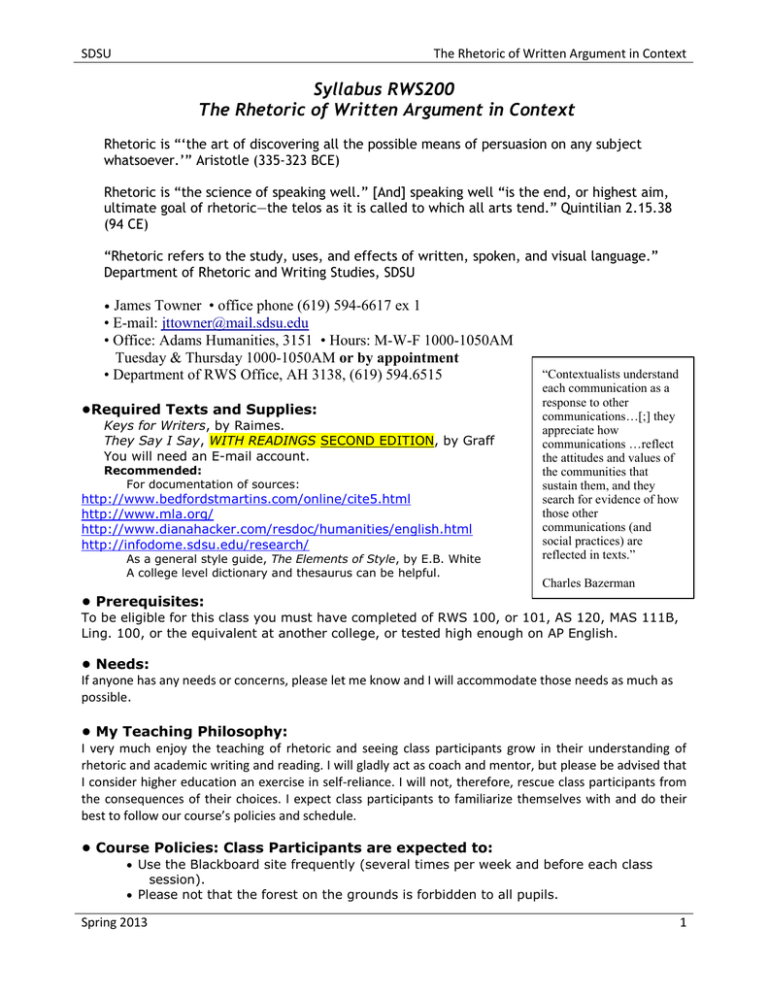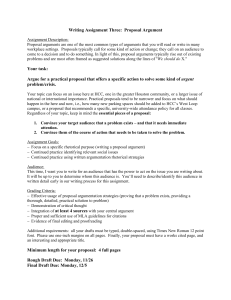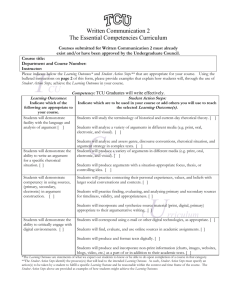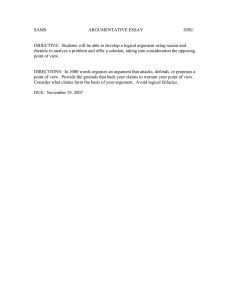Syllabus RWS200 The Rhetoric of Written Argument in Context
advertisement

SDSU The Rhetoric of Written Argument in Context Syllabus RWS200 The Rhetoric of Written Argument in Context Rhetoric is “‘the art of discovering all the possible means of persuasion on any subject whatsoever.’” Aristotle (335-323 BCE) Rhetoric is “the science of speaking well.” [And] speaking well “is the end, or highest aim, ultimate goal of rhetoric—the telos as it is called to which all arts tend.” Quintilian 2.15.38 (94 CE) “Rhetoric refers to the study, uses, and effects of written, spoken, and visual language.” Department of Rhetoric and Writing Studies, SDSU James Towner • office phone (619) 594-6617 ex 1 • E-mail: jttowner@mail.sdsu.edu • Office: Adams Humanities, 3151 • Hours: M-W-F 1000-1050AM Tuesday & Thursday 1000-1050AM or by appointment • Department of RWS Office, AH 3138, (619) 594.6515 • •Required Texts and Supplies: Keys for Writers, by Raimes. They Say I Say, WITH READINGS SECOND EDITION, by Graff You will need an E-mail account. Recommended: For documentation of sources: http://www.bedfordstmartins.com/online/cite5.html http://www.mla.org/ http://www.dianahacker.com/resdoc/humanities/english.html http://infodome.sdsu.edu/research/ As a general style guide, The Elements of Style, by E.B. White A college level dictionary and thesaurus can be helpful. “Contextualists understand each communication as a response to other communications…[;] they appreciate how communications …reflect the attitudes and values of the communities that sustain them, and they search for evidence of how those other communications (and social practices) are reflected in texts.” Charles Bazerman • Prerequisites: To be eligible for this class you must have completed of RWS 100, or 101, AS 120, MAS 111B, Ling. 100, or the equivalent at another college, or tested high enough on AP English. • Needs: If anyone has any needs or concerns, please let me know and I will accommodate those needs as much as possible. • My Teaching Philosophy: I very much enjoy the teaching of rhetoric and seeing class participants grow in their understanding of rhetoric and academic writing and reading. I will gladly act as coach and mentor, but please be advised that I consider higher education an exercise in self-reliance. I will not, therefore, rescue class participants from the consequences of their choices. I expect class participants to familiarize themselves with and do their best to follow our course’s policies and schedule. • Course Policies: Class Participants are expected to: Use the Blackboard site frequently (several times per week and before each class session). Please not that the forest on the grounds is forbidden to all pupils. Spring 2013 1 SDSU The Rhetoric of Written Argument in Context No magic in the corridors. Retrieve all assignment schedules, handouts, and other course documents from the blackboard site as indicated. Complete projects on the assigned dates. Late work will be accepted, if: 1) prior arrangements (at least 24 hours in advance) have been made with me, or 2) I agree circumstances prevented your timely completion of the assignment. See below for more on Late Work. Use compatible Microsoft Word documents when submitting assignments via Blackboard. Come to class prepared, regularly, and participate fully. • Course Description As described in the General Catalog: RWS 200 is one of several courses in the area of General Education defined as “Communication and Critical Thinking.” Focusing particularly on argument, this course emphasizes four essential General Education capacities: the ability to 1) construct, analyze and communicate arguments; 2) contextualize phenomena; 3) negotiate differences; and 4) apply theoretical models to the real world. This course advances General Education by helping students understand the general function of writing, speaking, visual texts, and thinking within the context of the university at large, rather than within specific disciplines. In addition to featuring the basic rules and conventions governing composition and presentation, RWS 200 establishes intellectual frameworks and analytical tools that help students explore, construct, critique, and integrate sophisticated texts. Within this framework of four general capacities, the course realizes four closely related subsidiary goals. These goals focus on helping students 1. Craft well-reasoned arguments for specific audiences; 2. Analyze a variety of texts commonly encountered in the academic setting; 3. Situate discourse within social, generic, cultural, and historic contexts; and assess the relative strengths of arguments and supporting evidence. Moreover, RWS200 is specifically designed for you to achieve these goals. We will build on the academic writing skills you have learned in high school and RWS100. In RWS100 you learned how writers use rhetorical strategies (appeals, style) to persuade their readers to accept or consider the writers’ claims—you constructed accounts of writers’ arguments, clarified parts of arguments with research, compared rhetorical strategies to engage audiences, and to frame one argument with another. In RWS 200 we shall emphasize the study of arguments in context. Context is defined by the Merriam-Webster Online Dictionary as: “the interrelated conditions in which something exists or occurs” (“context”). As in RWS 100 you will construct accounts of arguments and rhetorical strategies; however, in RWS 200 we shall emphasize the ways context and rhetorical situation shape writers’ rhetorical strategies. In the terms Graff, Birkenstein, and Durst in their 2011 book They Say, I Say, we will examine what authors “are responding to,” the “they say,” as well as to specific audiences. We will read and discuss selections from our text, exploring how the context and rhetorical situation may have shaped writers’ rhetorical strategies. In your own writing you will analyze the way writers use rhetorical strategies: extrinsic proofs (data, learned sources, facts), intrinsic proofs (appeals: ethos, pathos, and logos), and style (diction, detail, sentence structure) based on their particular rhetorical situations and contexts. For the most part, we will contextually analyze writing from the readings in They Say, I Say. Papers will include rhetorical and contextual analysis, recognizing parts of the argument, seeing how parts of the arguments work individually and together, research. In your papers you will revise your own work over several drafts, and edit for academic and MLA style. All of our work allows you to achieve the RWS 200’s Leaning Outcomes listed below. Spring 2013 2 SDSU “Was the teaching of rhetoric ever called into question? The answer is ‘yes.’ Just as today ‘rhetoric’ in popular usage can have negative connotations as deceitful or empty, so it was viewed with hostility or suspicion by some in classical times.” The Rhetoric of Written Argument in Context • Student Learning Outcomes for RWS 200: The following four outcomes describe the four major writing projects or “assignment types” and Outcomes for our course. Our writing projects will promote Student’s ability to: 1. Construct an account of an argument and identify elements of context embedded in it, the clues that show what the argument is responding to—both in the sense of what has come before it and in the sense that it is written for an audience in a particular time and place; examine a writer’s language in relation to audience, context and community; 2. Follow avenues of investigation that are opened by noticing elements of context; research those elements and show how one's understanding of the argument is developed, changed, or evolved by looking into its context; 3. Given the common concerns of two or more arguments, discuss how the claims George Kennedy of these arguments modify, complicate or qualify one another; 4. Consider [your] contemporary, current life as the context within which [you] are reading the arguments assigned in the class; position [yourself] in relation to these arguments and additional ones [you] have researched in order to make an argument; draw on available key terms, concepts or frameworks of analysis to help shape the argument. The following points describe outcomes to work on throughout the semester, to be attained over the 15 weeks. 1. Building on the work done in RWS 100, students will be able to: articulate what argument a text is making; describe the work that is done by each section of the argument; describe elements of the argument—claims, methods of development, kinds of evidence, persuasive appeals; translate an argument into their own words; 2. Understand and incorporate all aspects of the writing process--including prewriting, drafting, revising, editing, and proofreading; 3. Articulate what key terms, definitions, concepts, statements of a problem or issue are established by a text; 4. Investigate and articulate how an argument is positioned—based on certain kinds of assumptions, located in a way of thinking and representing issues from a point of view; 5. Work with multiples sources in a paper, deciding what to include and what to exclude, choosing an effective structure, and creating significant relationships among sources; 6. Analyze and assess arguments made by visual texts; incorporate visual images into their documents; 7. Craft a cohesive paper, and use effective metadiscourse to articulate the project of the paper and guide a reader through it; 8. Describe their own papers and reflect on how they wrote them; differentiate between the content of their texts and the language and rhetorical strategies they employ; 9. Assign significance to the arguments they read; 10. Revise their own work effectively, re-reading previous work and re-envisioning it in the light of reflection, feedback, further reading and new sources of information; 11. And, edit their writing for the grammar and usage conventions appropriate to the project. • Excused absences: Class participants who participate in sports, school, personal, or religious activities that require the student to be absent are excused. However, I need proof of your need to miss class. All work due on the day of absences must be submitted on time, unless prior arrangements are made with me your instructor. Spring 2013 3 SDSU The Rhetoric of Written Argument in Context • Course Work: Along with several reading assignments, you may earn up to 100 points for Short Writing: ‘Short writing’ assignments include peer revision worksheets. Also, I will ask you to type answers to some of the “Joining the Conversation” questions that follow each reading in They Say. The ‘Short Writing’ will help you achieve Learning Outcomes 5, 6, & 12. Moreover, the short writes will prepare you for the Projects and class discussion. As a side benefit, since writing is a practical craft/art, the ‘Short Writing’ provides you with practice to refine your writing skills. Please type and single space short assignments written outside of class. Print and bring to class. To save paper, print back to back. Assessment of Short Writing: Your Short Writing will be given a holistic grade on a scale of 1-10; 10 Outstanding, 9 Excellent, 8 Praiseworthy, 7 Competent, 6 Minimally Passable, 0 Unacceptable. I encourage appropriate quotes from the readings—but avoid too much quoting. Usually, one or two quotes per answer is enough. Use MLA style. Please use Lead Phrases with quotes and summary; see They Say, I Say pp. 38-40 & 42-44. No make-up homework without good, verifiable reason. Short Writing Criterion: Development Engages with question Uses quotes appropriately Grammar Punctuation 10 9 8 7 6 O Outstanding Clearly, thoughtfully Very full Full Adequate Barely Off topic Very full Clearly Adequate Barely Off topic Mostly Some Barely OMG Few Some Frequent OMG Few Some Frequent OMG Always Nearly ErrorFree Nearly ErrorFree Nearly always Nearly always Nearly always 900 points for 4 Revised Writing Projects: Class participants will create, as the Learning Objectives suggest, four Writing Projects of varying design, length, and purpose. Each will explore the contextual and rhetorical elements of the readings in our text; some papers will involve research. Format of Papers: MLA style HOWEVER, Single space homework—to save paper. Citing sources in-text: MLA style Lead phrases are expected See Raimes, pp. 137-49. And see They Say, I Say pp. 42-44. Include as many sources as set by the prompt, most important: clearly respond to the prompt. Papers should read smoothly with an academic tone and style. Class participants will submit rough drafts in conferences with me. Final drafts will be submitted to Blackboard, Assignment page. Also save copies of articles, web sites, interviews, surveys, etc., that you cite in your papers and are not in our text. • Project One asks you to “construct an account of an argument and identify elements of context embedded in it, the clues that show what the argument is responding to—both in the sense of what has come before it and in the sense that it is written for an audience in a particular time and place.” • Project Two asks you to research an element of context and write a conventional academic paper explaining how your research will improve a reader’s understanding of the text. (See learning outcome #2.). • Project Three asks you to examine and synthesize the larger conversation in which arguments take place. You will show how several texts on the same topic present differing arguments and Spring 2013 4 SDSU The Rhetoric of Written Argument in Context how these texts modify, complicate, or qualify one another. (See learning outcome #3.) • Project Four asks you to take a position within a debate, drawing on the writer’s awareness and understanding of the cultural conversation about the topic. To position yourself within a debate, you will refer to specific author’s arguments. In this way you will, thus, situate yourself within an ongoing discourse. (See learning outcome #4.) • Course Grade, 1000 point maximum: Your Course Grade is earned by the total points you earn for the four writing assignments and the several Short Writing assignments. So for example, if you earn a total of 850 points, your grade would be a B. If you earned 777 points, your grade would be a C+. If you earned 880 points, your grade would be a B+. If you earned a total of 901 points, your grade would be an A-. Rough Draft Peer Mark Final Draft Short Writing Prj 1 Prj 2 Prj 3 Prj 4 n/a 15 15 15 25 n/a 10 100 10 175 200 10 175 200 10 225 250 n/a Total Points 940-1000 900-939 870-899 840-869 800-839 770-799 740-769 700-739 670-699 640-669 600-639 0-599 225 250 Max Possible 1,000 GRADE A AB+ B BC+ C or CR C- or N/C D+ or N/C D or N/C D- or N/C F or N/C • Late Work: Although I reserve the right to allow late submissions, please complete your assignments on time. If a paper is due, for example, on a Monday, it must be turned in that day during class or on Blackboard Assignment Page or other specified time. Assignments (answers to “Engaging the Text,” reading, research, or group projects) should be completed before the class meeting listed in the schedule. If you have a VERIFIABLE AND LEGITIMATE reason for missing class when a paper is due (such as serious illness, a death in the family), you may bring the paper to the next class meeting and it will be accepted. Spring 2013 5 SDSU The Rhetoric of Written Argument in Context TURNITIN WILL NOT ALLOW YOU TO SUBMIT LATE ‘rough’ DRAFTS. Late papers will be REDUCED 10-20% of point value, at my discretion. Missing assignments earn 0 points. PLEASE: Make extra copies of your work before turning in. I reserve the right to ask for rewrites of assignments and to allow, at my discretion, late submissions. PLEASE: Keep hard and digital copies of all work, including homework. • Dropping: Class participants have 15 days from the first day of term to finalize ads and drops. Professors cannot drop class participants. Dropping is the responsibility of and can only be done by class participants. Class participants, who stop attending class but do not drop, must be given a grade. • Plagiarism and Cheating Plagiarism: REMEMBER, when we use the IDEAS, CONCEPTS, STRUCTURE, words, phrases (even 2 or 3 words) of another person (a source) we must document that person/ source. And we must put all borrowed words and phrases inside quotation marks. READ: Raimes, Keys for Writers, chapter 9, “Avoiding Plagiarism.” Cheating: Also, I highly recommend tutoring and comments from others. However, allowing someone else actually to write or dictate substantial phrases, sentences, or parts of your paper for you is cheating. Also, turning in work, revised or not, done for other classes will be considered cheating. Using peer’s work or work written by others and revised as your own is cheating and plagiarism. Work containing plagiarism is a serious academic offense and will be given 0 points, and you will be reported to the Office of Students Rights and Responsibilities. Classroom Etiquette: Be here now. This is your life. So when in our classroom, participate fully in classroom activities: discussions, peer revision and editing, etc. Respect all speakers. Whether instructor or student refrain from side conversations and give speakers your full attention and treating each other civilly. Confused? Ask for clarification of any confusing points on assignments or lectures. Late? Please enter class quietly, take a seat near the door, and generally make as little disturbance as possible. And bring us coffee or candy or doughnuts. Messed up? If you’re feeling sick, have an on-going medical problem, please tell me at the beginning of class, sit near the door, and if needed leave quietly. Messy puppy? Keep our dungeon clean. Pick up and clean up please, since no one likes sitting in somebody else’s trash. Right? No brooms for first years. AND GOOD LUCK! Spring 2013 6




